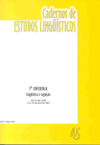Resumo
In this article hypothesis of how children acquire the passive constructions are discussed. Furthermore, results of four studies testing comprehension and production of passives in children and adults speakers of English and Portuguese are described, showing that the proportion of passives usage presents significant variation depending on the subject native language and age.Referências
BATES, E. & MACWHINNEY, B. (1989). Functionalism and the Competition Model. in: MACWHINNEY & BATES, E. The crosslinguistic study of sentence processing. Cambridge: Cambridge University Press, 3-73
BORER, H. & WEXLER, K. (1987). The maturation of syntax. In: ROEPER, T. & WILLIANS, E. Parameter-setting and language acquisition. Dordrecht: Reidel.
DEMUTH, K. (1989). Maturation and the acquisition of the Sesotho passive. Language 65, 56-80.
ELMAN, J., BATES, E., JOHNSON, M., KARMILOFF-SMITH, A., PARISI, D. & PLUNKETT, K. (1996). Rethinking Innateness: a connectionist perspective on development. London: The MIT Press.
FRASER, C. BELLUGI, U. & BROWN, R. (1963). Control of grammar in imitation, comprehension and production. Journal of Verbal Learning and Verbal Behavior 2, 121-135.
GABRIEL, R. (2001). A aquisição de construções passivas em português e inglês: um estudo translinguístico. Porto Alegre: PUCRS. Tese de doutorado.
GIVÓN, T. (1984). Syntax: a functional-typological introduction, vol. 1. Philadelphia: John Benjamins
GIVÓN, T. (1990). Syntax: a functional-typological introduction, vol. 2. Philadelphia: John Benjamins
HOPPER, P. J. & THOMPSON, S. A. (1980). Transitivity in grammar and discourse. Language 56(2), 251-299.
MACWHINNEY, B. & BATES, E. (1989). The cross-linguistic study of sentence processing. Cambridge: Cambridge University Press.
MARCHMAN, V. A., BATES, E., BURKARDT, A. & GOOD, A. B. (1991). (Functional constraints in the acquisition of the passive: toward a model of the competence to perform). First Language 11, 65-92.
PEROTINO, S. (1995). Mecanismos de indeterminação do agente: o fenômeno da apassivação na aquisição da linguagem. Campinas: Unicamp. Dissertação de Mestrado.
PINKER, S. (1984). Language learnability and language development. Cambridge: Harvard University Press.
PINKER, S. (1999). Words and rules: the ingredients of language. London: Weidenfeld & Nicolson.
PINKER, S., LEBEAUXM, O. S. & FROST, L. A. (1987). Productivity and constraints in the acquisition of the passive. Cognition 26, 195-267.
RUMELHART, D., MCCLELLAND, J. & THE PDP RESEARCH GROUP. (1986). Parallel Distributed Processing: explorations in the microstructure of cognition. (vol. 1 and 2). London: The MIT Press.
SLOBIN, D. I. (1966). Grammatical transformations and sentence comprehension in childhood and adulthood. Journal of Verbal Learning Behavior 5, 219-227.
SLOBIN, D. I. (1981). The origins of grammatical encoding of events. In: DEUSTSCH, W. The child’s construction language: Academic Press, 187-199.
SLOBIN, D. I. (1985). A crosslinguistic study of language acquisition. London: Erlbaum.
TOMASELLO, M. (2000). The item-based nature of children’s early syntactic development. Trends in Cognitive Sciences 4(4).
O periódico Cadernos de Estudos Linguísticos utiliza a licença do Creative Commons (CC), preservando assim, a integridade dos artigos em ambiente de acesso aberto.

